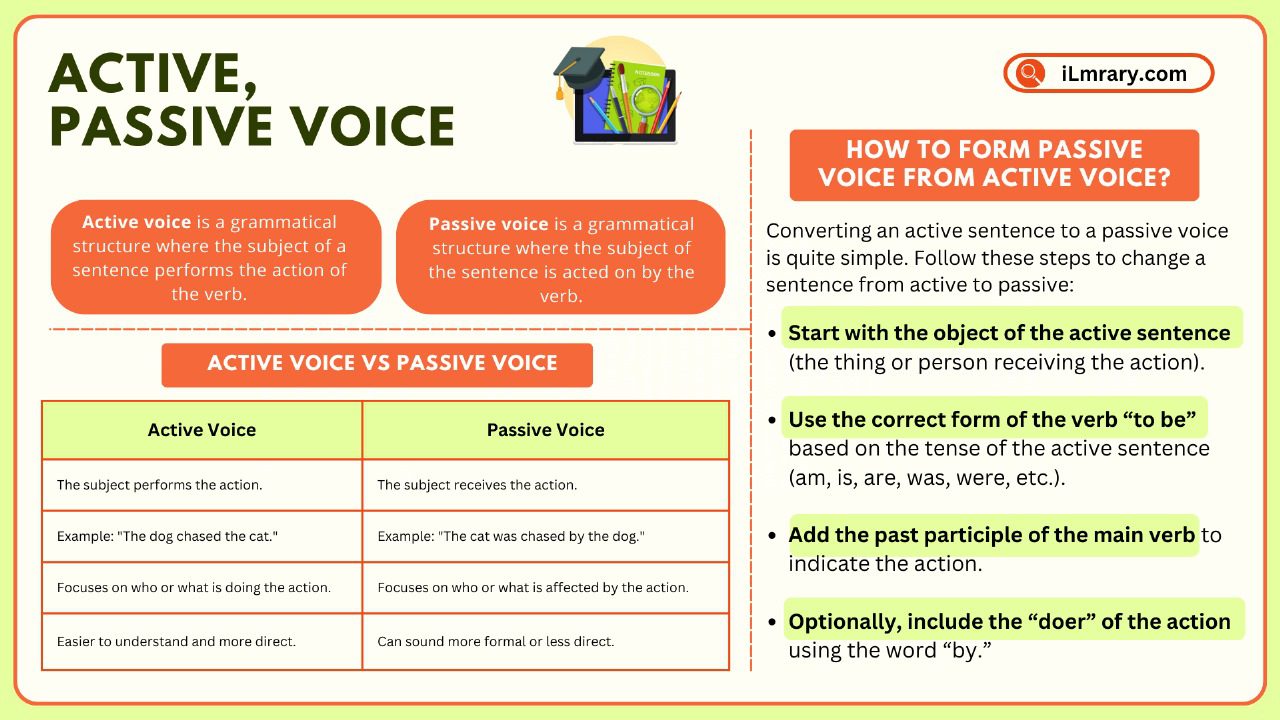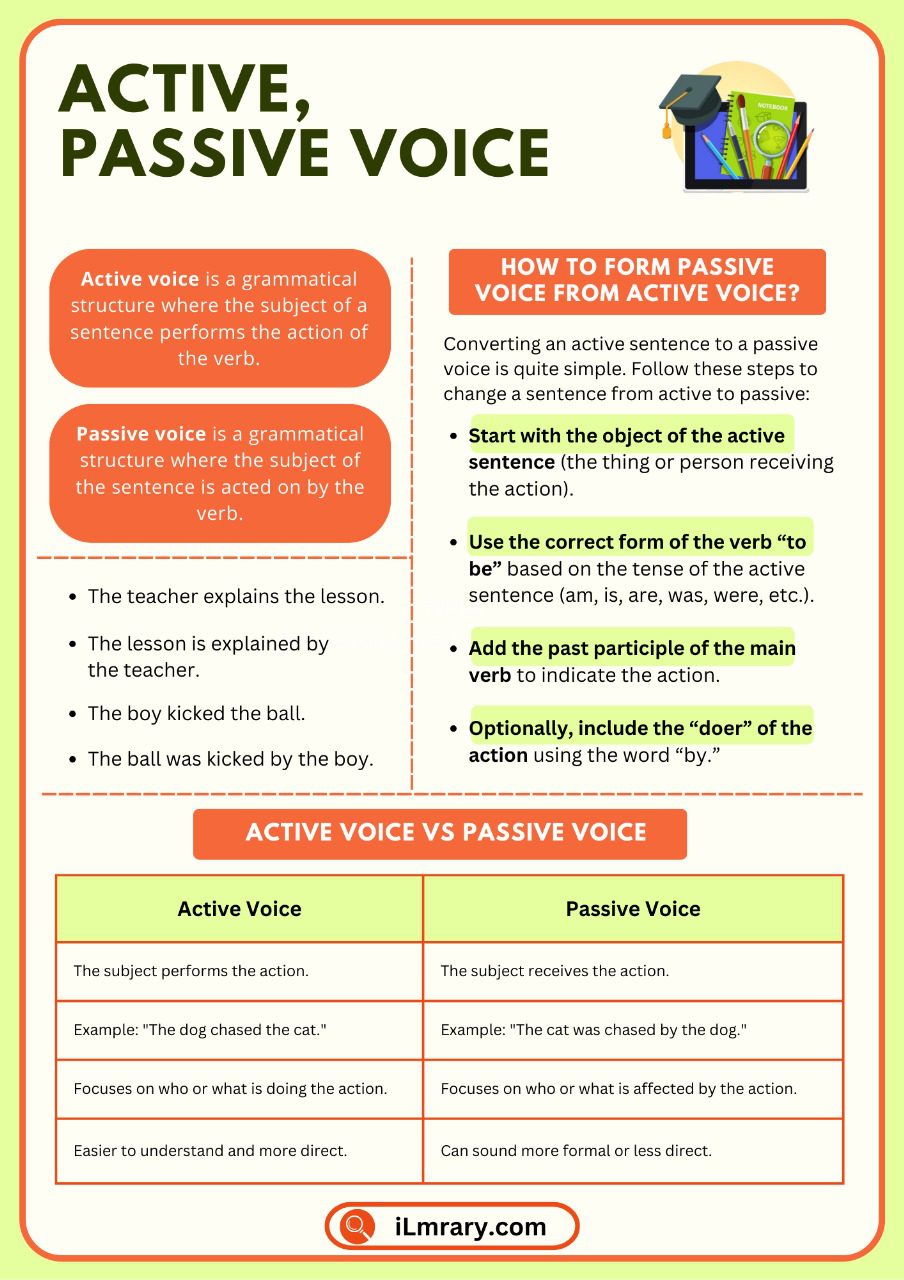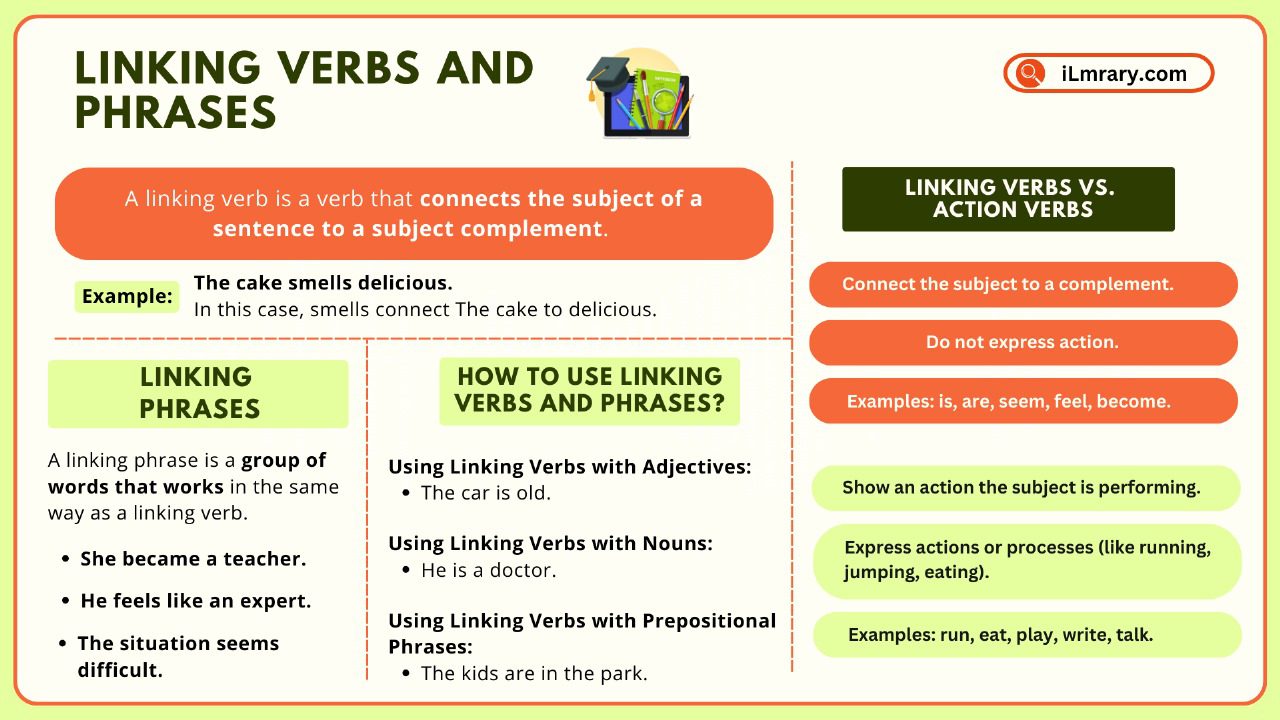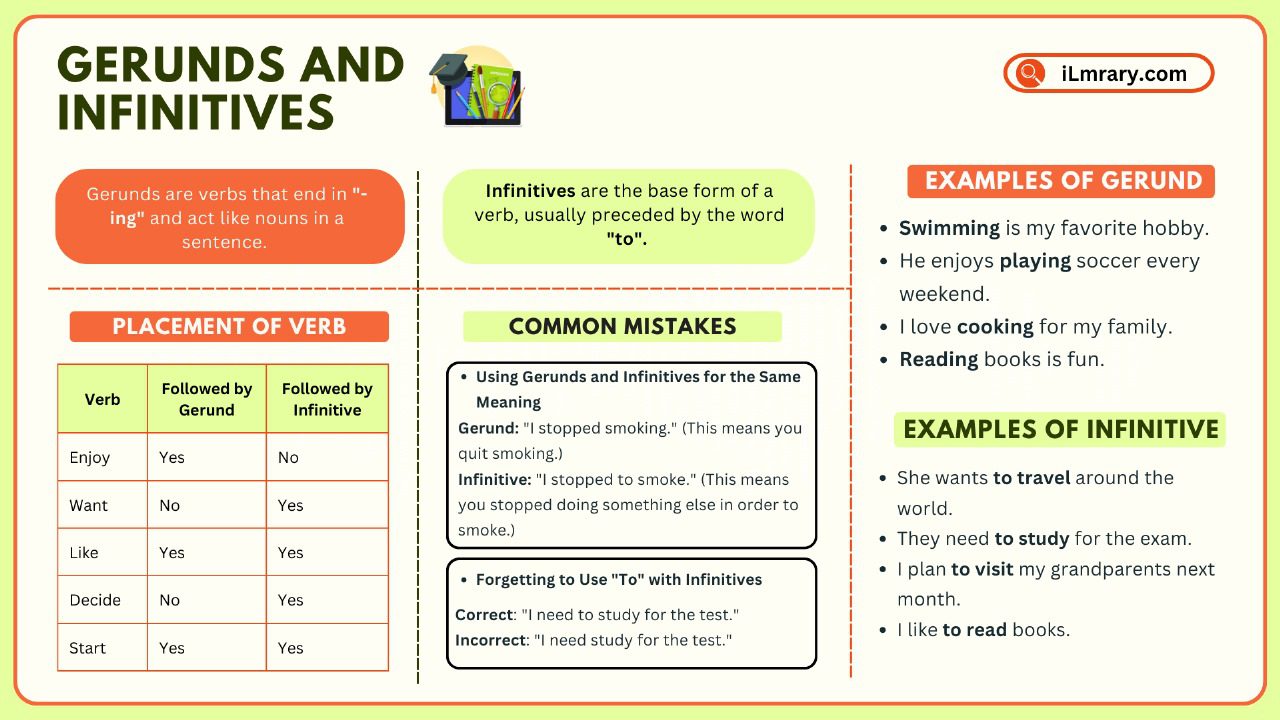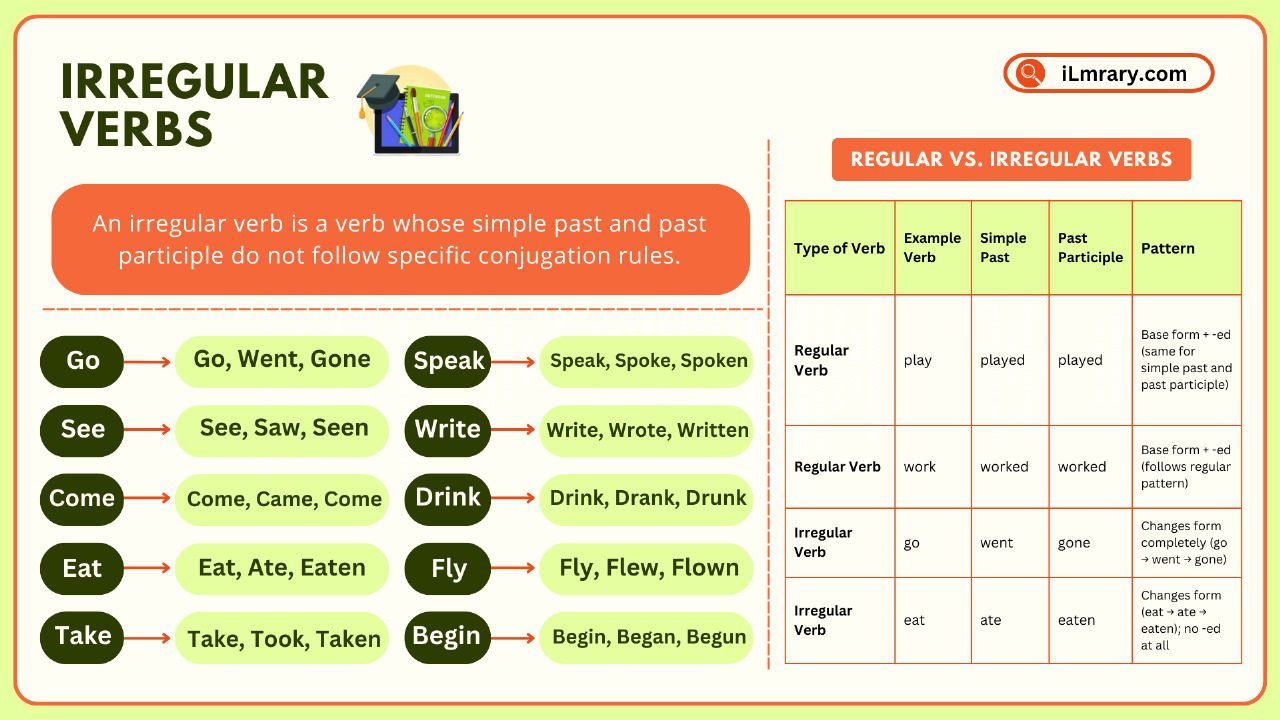When learning English grammar, one of the most important things to understand is the difference between active and passive voice. At first look, they might seem confusing, but once you know what they are and how to use them, it becomes easier to write and speak in a way that sounds natural and clear.
In this post, we will explain both voices and explain when to use each one effectively. Whether you’re writing or speaking, understanding these two forms will help improve your communication skills.
Contents
What is Active Voice?
The active voice is one of the most common ways to structure sentences in English. In an active voice sentence, the subject of the sentence is the one doing the action. This structure is direct and straightforward. Think of the subject as the “doer” of the action. When using active voice, you are essentially saying who is performing the action and what that action is.
Key Features of Active Voice:
- The subject performs the action.
- It focuses on who is doing the action.
- It is simple and easy to understand, making it ideal for everyday use.
Example of Active Voice:
- The teacher explains the lesson.
In this example, the subject “teacher” is performing the action “explains.” The focus is on the teacher doing the explaining.
What is Passive Voice?
In passive voice, the subject of the sentence is not the one doing the action. Instead, the action is being done to the subject. In this way, the focus shifts from the doer of the action to the receiver of the action. In many cases, the person or thing doing the action is not even mentioned, but if it is, it comes at the end of the sentence, introduced by the word “by.”
Key Features of Passive Voice:
- The subject receives the action.
- The focus is on what happens to the subject rather than who is performing the action.
- Passive voice can sound more formal, which is why it’s often used in academic writing or formal contexts.
Example of Passive Voice:
- The lesson is explained by the teacher.
Here, the subject “lesson” is the receiver of the action. The focus is on the lesson itself, rather than the teacher doing the explaining.
Comparison Between Active and Passive Voice
Understanding the major differences between active and passive voice is key to understanding both. While they may seem similar, each has its own place depending on the message you want to convey and how you want to structure your sentence.
Here’s a simple comparison to help clarify the differences:
| Active Voice | Passive Voice |
| The subject performs the action. | The subject receives the action. |
| Example: “The dog chased the cat.” | Example: “The cat was chased by the dog.” |
| Focuses on who or what is doing the action. | Focuses on who or what is affected by the action. |
| Easier to understand and more direct. | Can sound more formal or less direct. |
| Often used in everyday speech and writing. | Often used in scientific or formal writing. |
How to Change Passive Voice from Active Voice
Converting a sentence from active to passive voice is simple. Follow these steps, and we’ll provide an example for each step:
⇒ Identify the Object:
The first thing you do is identify the object in the active sentence (the thing or person receiving the action).
- Active Voice: The boy kicked the ball.
- Object: The ball (this is what received the action).
⇒ Use the Correct Form of ‘To Be’:
Choose the correct form of the verb “to be” based on the tense of the active sentence. For example, use am, is, are for present, was, were for past, and so on.
- Active Voice: The boy kicked the ball.
- The tense is past, so we use was.
⇔ Use the Past Participle:
Add the past participle of the main verb to show the action.
- Active Voice: The boy kicked the ball.
- The past participle of “kick” is kicked.
⇒ Optionally Include the Doer:
If you want to mention the doer of the action (the subject in the active voice), you can include them using “by.”
- Active Voice: The boy kicked the ball.
- Passive Voice: The ball was kicked by the boy.
(Here, “the boy” is the doer, but it’s optional to include “by the boy.”)
Full Example:
- Active Voice: The boy kicked the ball.
- Passive Voice: The ball was kicked by the boy.
Key Points to Remember:
- In active voice, the subject performs the action.
- In passive voice, the object of the action becomes the subject.
- The verb “to be” must match the tense of the active sentence.
Quick Tip:
In passive voice, the focus shifts to the action or the recipient rather than the doer.
Common Mistakes to Avoid in Active and Passive Voice
⇔ Using Passive Voice Too Often
While passive voice is useful, using it too often can make your writing unclear or sound awkward. It’s important to choose the right voice for the situation.
Solution:
Use active voice most of the time because it keeps your writing clear and direct. Passive voice should be used when the focus is on the action or when the doer is unknown or unimportant.
- Active Voice: The chef prepared the meal.
- Passive Voice: The meal was prepared by the chef.
⇔ Overuse of Passive:
The meal was prepared by the chef, the table was set by the waiter, and the food was served by the assistant. (This is repetitive and unnecessary.)
⇔ Not Properly Converting Tenses
When you change from active to passive voice, make sure the verb tense stays the same. This is a common mistake where the tense gets changed or mismatched.
Solution:
Make sure the tense of the main verb in the passive sentence matches the tense of the active sentence.
- Active Voice (Present Tense): She reads the book.
- Passive Voice (Present Tense): The book is read by her.
⇔ Forgetting to Use the Correct Form of “To Be”
When changing from active to passive, you need to make sure you’re using the right form of the verb “to be.” This is a crucial part of passive voice.
Solution:
Ensure the form of “to be” matches the tense of the active sentence.
- Active Voice (Past Tense): They built the house.
- Passive Voice (Past Tense): The house was built by them.
Additional Tip: Focus on the Action
Remember, passive voice emphasizes the action or the object, while active voice emphasizes the doer. Use passive voice when the “doer” isn’t important, or when the action itself is more important than who performed it.
Modal Verbs and Their Role in Passive Voice
Modal verbs (like can, could, may, might, must, shall, should, will, would) are commonly used in passive voice constructions. When using modal verbs in the passive voice, the formula is straightforward:
Subject + Modal Verb (can, should, must, etc.) + be + Past Participle of the main verb
Let’s break this down further with examples for better clarity:
⇔ Can (ability)
- Active Voice: The chef can prepare the meals every morning.
- Passive Voice: The meals can be prepared (by the chef) every morning.
Here, can shows ability. When we turn the sentence into passive, the focus is on the meals (the object) instead of the chef (the doer).
⇔ Must (necessity)
- Active Voice: You must complete the assignment by Friday.
- Passive Voice: The assignment must be completed by Friday.
In this case, must expresses necessity. In the passive voice, the sentence still conveys that the assignment has to be completed, just without focusing on the person who must complete it.
⇔ Should (advice or expectation)
- Active Voice: We should clean the house before the guests arrive.
- Passive Voice: The house should be cleaned before the guests arrive.
Here, should expresses advice or expectation, but in passive voice, the focus is on the house that needs to be cleaned.
Formula Recap:
Subject + Modal Verb + be + Past Participle
- Active: [Subject] + [Modal Verb] + [Main Verb]
- Passive: [Subject] + [Modal Verb] + be + [Past Participle of the Main Verb]
Additional Notes:
- Use of “by”:
You can optionally add the agent (the doer of the action) with “by,” but often it’s left out because it’s understood or unimportant in passive sentences. For example: “The meals can be prepared by the chef,” or simply, “The meals can be prepared.”
- Modal verbs in passive voice maintain their meaning:
The modal verbs still express ability, necessity, or advice, but the focus shifts from the person doing the action to the object receiving the action.
Use of “Be” Verb Forms in Passive Voice
In the passive voice, the verb “to be” is crucial. Depending on the tense, you will choose from am, is, are, was, were, being, been and so on, followed by the past participle of the main verb. Here are some examples in different tenses:
Present Simple:
- Active: They build new houses in the area.
- Passive: New houses are built in the area.
Past Simple:
- Active: The chef prepared the meals last night.
- Passive: The meals were prepared last night.
Present Continuous:
- Active: They are renovating the building.
- Passive: The building is being renovated.
No matter what tense you use, the “be” verb indicates the passive form when combined with the past participle.
Real-Life Scenarios for Understanding Both Voices
Knowing when to use active vs. passive voice can be just as important as how to form them. Below are some real-life situations:
1 – Writing an Email (Active Voice Preferred)
- Active: We will review your request and send a response soon.
This direct tone sounds friendly and clear.
2 – Giving a Presentation (Mix of Active and Passive)
- Active: The team conducted the study last month.
- Passive: The results were analyzed by our research department.
In presentations, you may want to highlight actions in an active way, but also focus on results using the passive.
3 – Writing an Academic Paper (Passive Voice Common)
- Passive: The experiment was conducted to determine the reaction rate.
In academic writing, the passive voice is often used to focus on the process rather than the person who performed the experiment.
Using Passive Voice for Emphasis or Politeness
While the active voice generally provides clarity, there are situations in everyday communication where the passive voice can add politeness or emphasize a particular element. Here are two ways it can be helpful:
1 – Emphasizing a Result
When you want to focus on what happened rather than who performed the action, the passive voice allows the result or object to stand out.
For Example:
- A new policy was introduced last week.
This sentence highlights the new policy, rather than who introduced it.
2 – Softening Criticism or Advice
In polite or diplomatic contexts, passive constructions can reduce the sense of blame or directness.
For Example:
- Mistakes were made.
Instead of saying, You made mistakes, the passive voice keeps the statement factual but less accusatory.
FAQs:
When you practice active and passive voice, you will have some questions. That is why we have answered some common questions that learners often ask about these two voices below.
Q1: Can I always use active voice in my writing?
Active voice is ideal for most situations, especially in informal or everyday communication. However, passive voice can be helpful in formal contexts or when the focus is on the action itself.
Q2: Is passive voice bad?
No, passive voice is not bad. It’s just different. Moreover, it’s useful in specific contexts but should be used carefully to avoid making your writing sound too indirect or complicated.
Q3: How do I know when to use passive voice?
Use passive voice when the doer of the action is not important, unknown, or when you want to focus on the result or the action itself. It is common in formal, scientific, and objective writing.
Conclusion
To sum up, understanding the difference between active and passive voice is essential for improving your English composition grammar. While active voice is generally simpler and more direct, passive voice has its own uses in more formal writing or when the focus needs to be on the action rather than the doer. Therefore, by mastering both voices, you can make your writing clearer and more effective. Remember to choose the voice that best suits the context of your writing.
You May also like:


